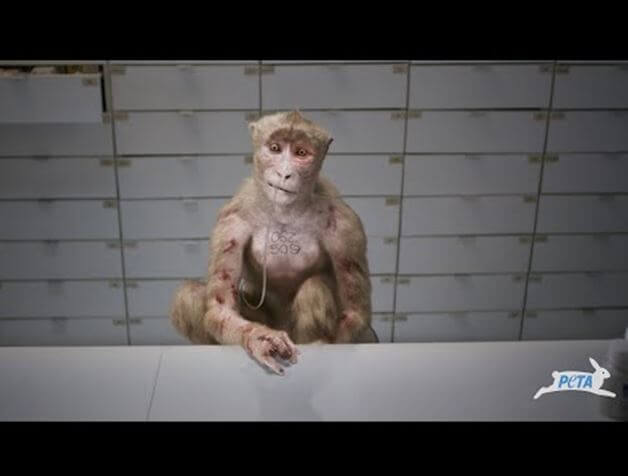Because experiments on monkeys are so gruesome that no TV station could possibly air them, PETA used CGI to create a new TV spot that reveals—without showing any real animals, gore, or blood—who pays the real price for pharmaceutical drugs tested on animals. But many TV stations are still refusing to run even this PG-rated, animated video, calling it “too graphic” and “triggering” and citing probable “viewer complaints.”
In the 15-second spot, a “customer” wants to know how much a prescription will cost—and a computer-generated monkey, tattooed with an ID number and wheezing through a breathing tube, has the answer: “Too much.” The video is part of a new series from PETA that also takes on the hefty price animals pay for cheese and cashmere. These two ads are slated to run widely on TV and movie screens throughout the holiday season.
“If a computer-generated monkey is ‘too much’ for TV, imagine how consumers would react to seeing real footage from inside laboratories, where monkeys are caged, pumped full of chemicals, infected with diseases, and killed for pointless experiments that don’t benefit human health,” says PETA Senior Vice President Kathy Guillermo. “PETA is rallying viewers to stand against real-life horrors for animals by calling on U.S. laboratories to pivot to sophisticated, human-relevant research methods.”
Even though studies show that 90% of all basic research—most of which involves animals—fails to lead to treatments for humans, 110 million animals are killed in U.S. laboratories every year and the National Institutes of Health spends $20 billion—nearly half its annual budget—on animal experiments.
The monkey ad was rejected by multiple TV stations in Indianapolis; Reno, Nevada; and Sacramento, California. Only a few individual stations agreed to run the ad—in San Diego (near Charles River Laboratories); Madison, Wisconsin; and San Antonio (both near federally-funded National Primate Research Centers)— as well as local stations via Comcast in the Hartford, Connecticut, metropolitan area in time for the Harvard-Yale football game on November 18.
More stations agreed to air the videos in which a computer-generated calf chained up behind a shop’s register and swarming with flies reveals that a wedge of cheese costs “too much”—as revealed in a PETA investigation into Daisy Farms—and in which a computer-generated goat points out that cashmere costs “too much” for the goats who scream in pain as workers rip out their hair, as shown in PETA Asia’s investigations into the cashmere industry. Both ads are running on area networks in Charleston, South Carolina; Colorado Springs, Colorado; and Sacramento. Additionally, the calf video will be seen at movie theaters in Sacramento and San Antonio. Altogether, PETA’s “Too Much” videos will air nearly 13,000 times on screens across the country.
PETA’s motto reads, “Animals are not ours to experiment on, eat, wear, use for entertainment, or abuse in any other way.” For more information, please visit PETA.org, listen to The PETA Podcast, or follow the group on X (formerly Twitter), Facebook, or Instagram.
The post ‘Too Graphic’: TV Stations Block Tame PETA CGI Spot Aimed at Monkey Laboratories appeared first on PETA.

